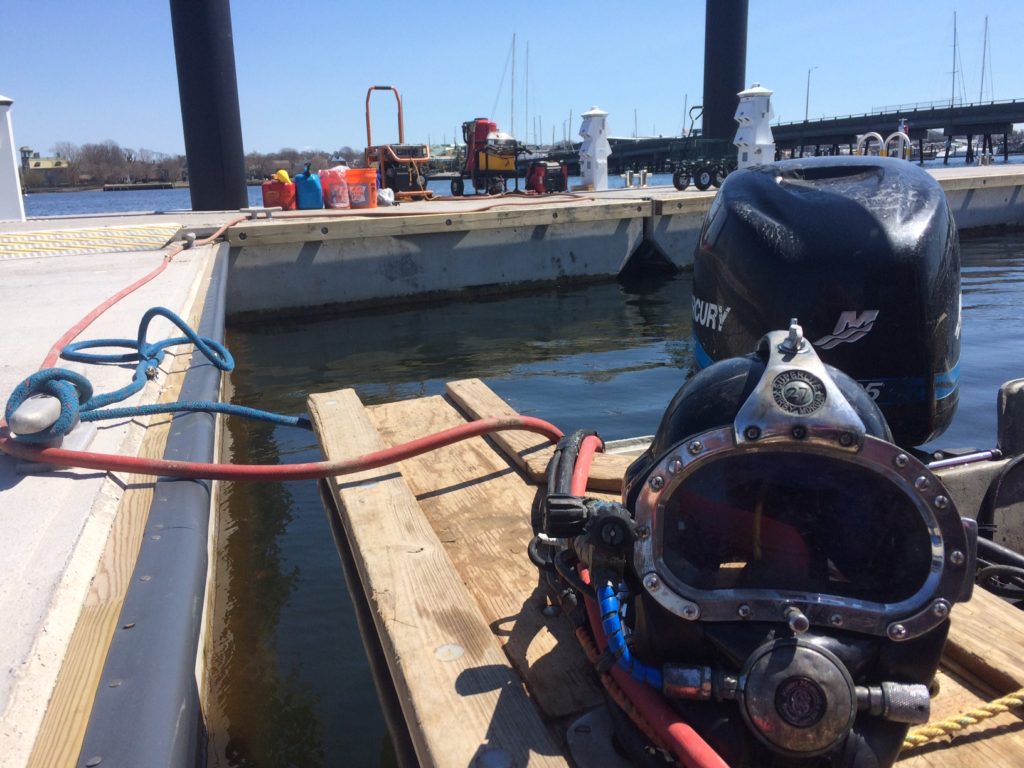 This week was one of those weeks – a marathon stretch of hard mud diving every day which equated to just shy of 30 hours underwater within a 5 day stretch, with one day including a 7 hour dive. I’ve had lots of weeks like this, for better or worse, and they always manage to bring forward some of the harsh realities of the trade, while leaving the glamour of diving hidden in the background.
This week was one of those weeks – a marathon stretch of hard mud diving every day which equated to just shy of 30 hours underwater within a 5 day stretch, with one day including a 7 hour dive. I’ve had lots of weeks like this, for better or worse, and they always manage to bring forward some of the harsh realities of the trade, while leaving the glamour of diving hidden in the background.
So, what the heck was I doing for 30 hours down there? Well, I was being part underwater engineer, part underwater carpenter, and part underwater trash man. We were tasked with installing several thousands of pounds of foam flotation to a new concrete floating dock to make it more level and sit just a wee bit higher. That meant lots of repetitive exercises in displacement, careful rigging, and attention paid to diver positioning so as to not get crushed or pinned by the thousands of pounds of ballast and buoyancy we were working with…I got away with just smashing my left index finger.
As much as everyone wants to be ‘the diver’ and put on the hat (slang for diver’s helmet) for the glory shot, very few can cut it through the very demanding work conditions. Let’s explore what a seven hour stretch underwater does to you…
First, dehydration is a major factor. Between breathing dry filtered air, and wearing a hotwater suit that makes you sweat all day, and the salt immersion causing you to go through some osmosis, you can drop several pounds of water weight in a single day. That can be very dangerous physiologically. Your nails become very, very soft, almost to the point of losing them (I did lose one several year ago which is not a pretty sight). I actually think that nails absorb some water and appear to grow faster with lengthy immersions – just one of those observations. You tend to get skin fungus from being so wet and immersed in heated marina seawater which is like being incubated in a microbial ooze. Then there’s the stuff going on with your head. In the hat, your snoopy (helmet liner) ends up saturated with sweat to the point where its padding is of little benefit. Your ears chafe inside the wet liner. Your nose ends up raw and chapped from the nose block jamming up under your nose at your upper lip. Then, your breathing gets progressively more labored as your lungs tire out from working the regulator day after day.
And then there are the more subtle changes that you don’t realize until you’ve done several hundreds of similar days underwater – you lose your sense of smell, probably given that it isn’t used for lengthy blocks of time, as there’s nothing coming at you except sweat and spooge mud from the bottom. Your eyesight diminishes as well, probably again because you aren’t using it…you are working in a world of muted browns, greens, and in the shadows. And recently I’ve noticed bouts of slurred speech. I’ve noticed this in a few older divers as well. In jest, others on the crew have suggested that these old guys are tongue tied or even inbred, but now having experienced this myself I think there is something to it – one more effect on the brain to add to a thesis investigation one of these days. Just when you think it can’t get any worse, you are barely able to climb the ladder to get out because you’re both exhausted and have spent so much time in a weightless state that your muscles just aren’t cooperating like they should.
AND THEN, you dry out for a bit, eat like a pig, get some sleep, wake up and have to eat handfuls of ibuprofen for breakfast to deal with the aches and pains; lube up to deal with the rashes, chapped nose and lips; flush your ears to ward off festering infections; peel off multiple layers of skin and cut back those soft nails; and then cope with the various joints that tend to pop, and tendons that flare up. Sounds like old age, but it’s the diving.
Then you do it all over again. Why?

As glamorous as all that sounds, there is an upside…
Well, once you’re in the water all the pain goes away, its quiet, you can find peace with yourself, and realize the fruits of your labor in a world that most will never even experience. The challenge that comes with executing a task, with precision and professionalism, all while keeping yourself alive in an inherently compromised circumstance is amazingly rewarding. But more important than achieving the task is the continued path towards self-reliance and improved efficiency. While most people see the hat and that draws the oohs and aaahs, it’s what goes on in the background that leaves us with tremendous opportunity.
For every one guy in the water, on a simple inshore job anyway, you have two guys topside, and over a thousand pounds of machinery running, fuel burning, and lines stretched out and down to keep the diver going…an air compressor, comm box, hotwater machine, generators, well pumps, and it goes on. Keeping all of that stuff running hard day in and day out is an art unto itself, and speaks to the importance of the dive tender who is probably the most important guy [or gal] on the job. The tender is the direct interface between the dive supervisor and the diver and is constantly stuck playing the telephone game. A good tender is insightful, can anticipate the diver’s actions, and at the same time can relay the state of affairs to the supervisor in a way that will help direct the diver towards more efficient strides throughout the work day.
These days, being the diver for the most part, I am constantly looking at the mass of stuff needed to keep me going and trying to make it more streamlined, more efficient, and more cost-effective. With technology changing very quickly, this is an exciting time in diving, as not much has changed in commercial diving for quite some time, decades in fact. Today for example, many devices can run on 12 VDC, and making that switch alone for lights, cameras, comms, and other peripherals saves on generator requirements. In time, I can see more efficient means to deliver air to the diver, and more cost-effective means to keep the diver warm for these 7 hour immersions in 40 degree water. There is a tremendous amount of room for innovation – it’s an exciting time to be a working diver.
Looking ahead, these types of efficiencies are what will be needed to ‘cut the cord’ so to speak and enable more routinely relevant human intervention. By that I mean of course we have a good global population of scuba enthusiasts, but the tools of the trade that permit very lengthy and efficient working excursions are what will be needed when sea levels spring up ten feet and we have an entire planet needing massive waterfront infrastructure repairs that force all of us to live lifestyles that are more intertwined with the sea.
So, while I continue to beat up and abuse myself everyday, I know it’s not for naught…it’s a journey to find self-reliance and a greater efficiency that will bring us all a new life in the sea.
Related articles
 Doomsday by 2100 for West of Ireland if climate change continues
Doomsday by 2100 for West of Ireland if climate change continues Philippines earthquake recorded underwater by diver
Philippines earthquake recorded underwater by diver As Miami Beach battles rising seas, Dutch water expert offers advice
As Miami Beach battles rising seas, Dutch water expert offers advice Tens of thousands told to flee as floods swamp Australian town
Tens of thousands told to flee as floods swamp Australian town the ups and downs of mooring work | Oceans of Opportunity
the ups and downs of mooring work | Oceans of Opportunity






